Climbing the north face of Mount Everest reveals a world of high-altitude danger and historic achievement. This iconic route—on the Tibetan side—draws fewer climbers but demands more skill. Let’s explore its terrain, key features, and what makes it uniquely dramatic.
What Is the North Face of Mount Everest?
The north face of Mount Everest is the mountain’s northern side, accessible via Tibet. This remote region is known for steep couloirs, icy ridges, and harsh conditions. It’s a place where “a simple slip would mean death.”
Geography & Key Route Features
Climbers embark from Rongbuk Base Camp (~5,150 m). The route advances via the North Col—a glacial ridge connecting Everest and Changtse—and follows the Northeast Ridge.
Along the way are the infamous Three Steps—rock pinnacles near the summit at ~8,560 m, 8,610 m, and 8,710 m. The Second Step is nearly vertical and requires a ladder.
Two steep gullies—the Hornbein Couloir and Norton Couloir—flank the face. Hornbein, with inclines ranging from 47° to 60°, is especially treacherous.
History: Mysteries and First Ascents
In 1921, Mallory, Wheeler, and Bullock first reached the North Col. Mallory later returned with Sandy Irvine in 1924, vanishing near the summit. Mallory’s body was found in 1999.
The first confirmed summit via the northeast ridge from Tibet occurred on May 25, 1960, when Chinese climbers Wang Fuzhou, Qu Yinhua, and Gongbu reached the top.
The Hornbein Couloir was first climbed in 1963 by Tom Hornbein and Willi Unsoeld, who ascended the West Ridge before traversing to the north side.
Everest North Col: Access & Logistics
The Everest North Col is a high pass at ~7,000 m connecting Everest and Changtse. It was first reached in 1921 and serves as a staging area for climbers from Tibet.
Rongbuk Base Camp is accessed by road via Tingri and the Friendship Highway. A paved road built in 2015 made access far easier compared to Nepal’s approach.
Why Climb the North Face?
Advantages:
- Avoids the dangerous Khumbu Icefall of the south route.
- Fewer crowds and less congestion.
- Lower permit fees, though overall logistics can cost more.
Drawbacks:
- Harsh weather: fierce winds and extreme cold. Summit winds often exceed 100 km/h; temps near –30°C, with wind chills around –50°C.
- Technical terrain: the steep couloirs, three Steps, seracs, and icy slopes demand high skills.
- Longer summit day (16–20 hrs) and lower rescue support.
- Slightly lower success rate (~55% vs. ~65% on south route).
Climbing Challenges at a Glance
Comparing North vs. South Routes
The south (Nepal) route is more popular and structured. It has better support, helicopter evacuation, and more trekking amenities.
But it also includes hazards like the Khumbu Icefall and traffic jams near the Hillary Step. Overcrowding has even led to dangerous delays.
The north route offers solitude and fewer icefall dangers—but trades them for technical difficulty and exposure to climate extremities.
Conclusion
The north face of Mount Everest defines high‑altitude ambition. Its rugged landscapes, technical hazards, and chilling beauty make it both alluring and fearsome. From Mallory’s mysterious disappearance to modern expeditions via the Hornbein Couloir—this route encapsulates the harshest side of Everest.
For skilled climbers seeking a serious challenge beyond crowds and conventions, the north face remains the ultimate test.
FAQs
1. What is the North Col on Everest?
The North Col is a glacial pass (~7,000 m) between Everest and Changtse. It’s the main launch point for climbs via the north route. Mallory and team first reached it in 1921.
2. How does the Tibet climbing route compare to Nepal’s?
Tibet offers fewer climbers and no Khumbu Icefall, but colder weather, stricter permits, and longer summit days. Nepal’s route is more supported and socially immersive.
3. Can you trek to Everest Base Camp north?
Yes. Rongbuk Base Camp (~5,150 m) is reachable by vehicle via a paved road. It’s far easier than trekking to the south camp.
4. Why is the north face more dangerous?
Extreme wind, freezing cold, steep and technical terrain, high fatalities, and limited evacuation options make it more perilous.
5. Who first summited Everest via the north face?
On May 25, 1960, Chinese climbers Wang Fuzhou, Qu Yinhua, and Gongbu became the first to reach the summit via the north route.

